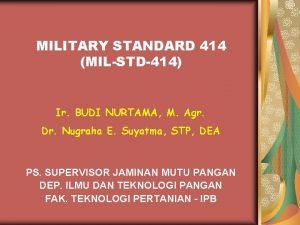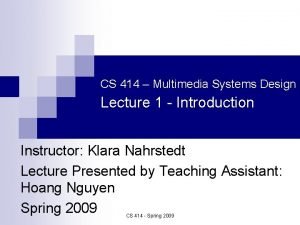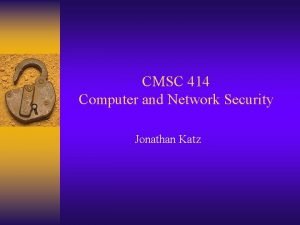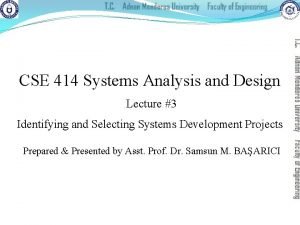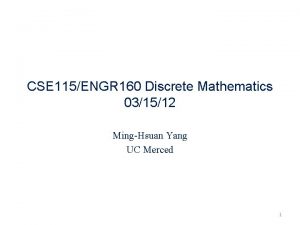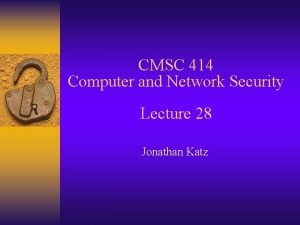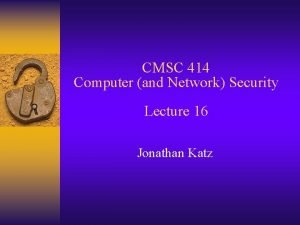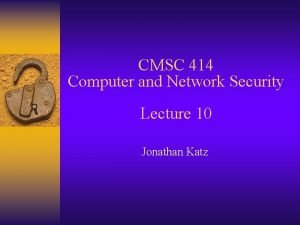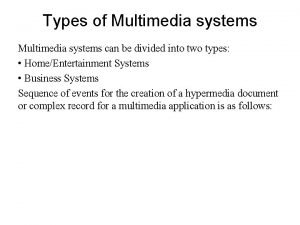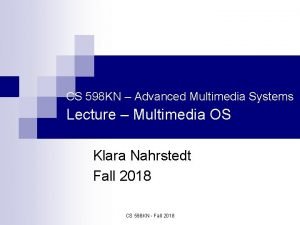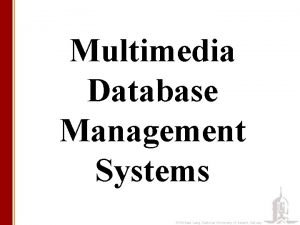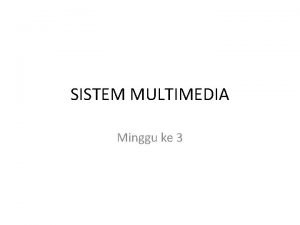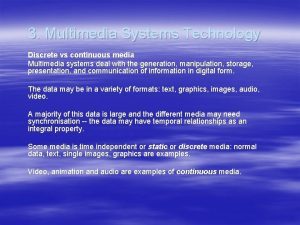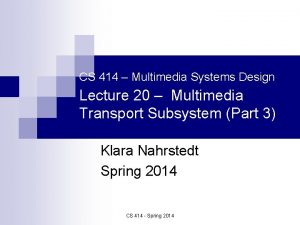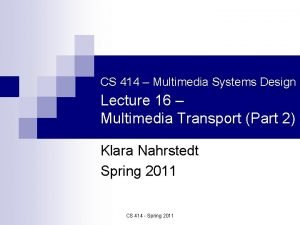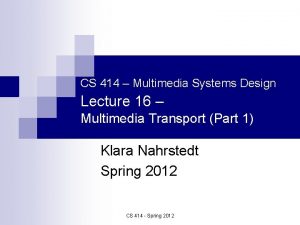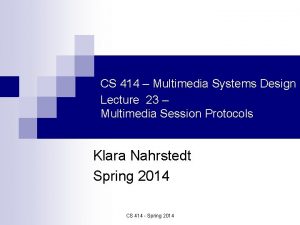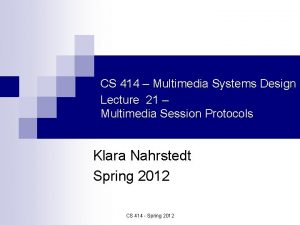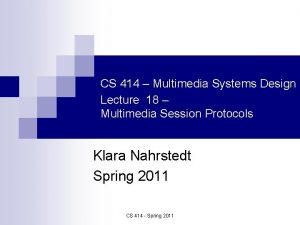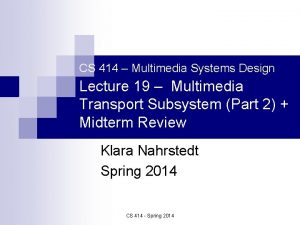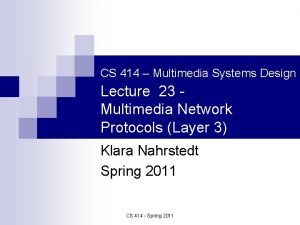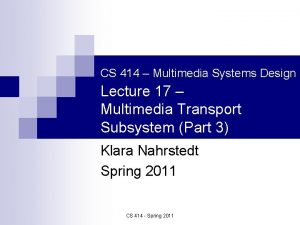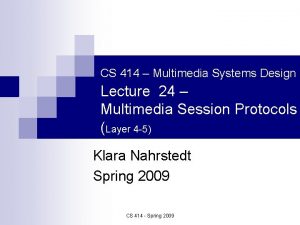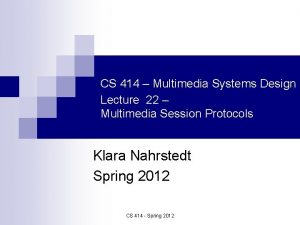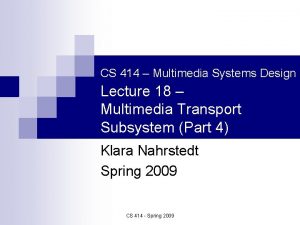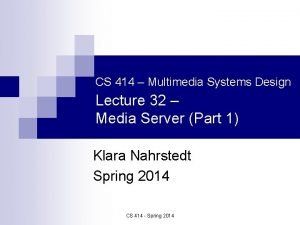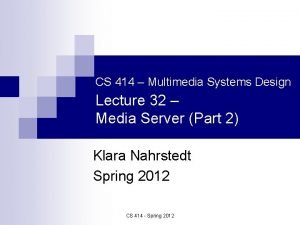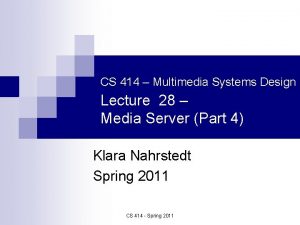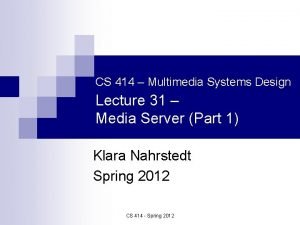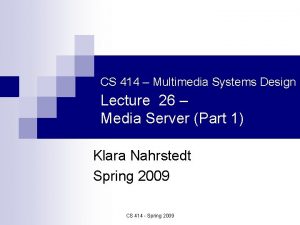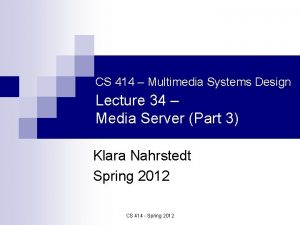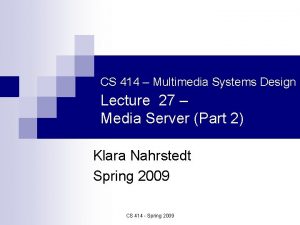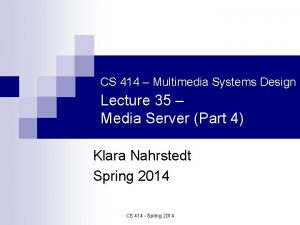CS 414 Multimedia Systems Design Lecture 33 Media




























- Slides: 28

CS 414 – Multimedia Systems Design Lecture 33 – Media Server (Part 2) Klara Nahrstedt Spring 2014 CS 414 - Spring 2014

Administrative MP 3 posted, April 15, 2014 n MP 3 deadline May 3, 5 pm (Saturday) n MP 3 presentations n ¨ n Monday, May 5, 5 -7 pm On Friday, April 18 – MP 3 discussion ¨ You are encouraged to bring your own design !!! - possibility to discuss your design with Shannon CS 414 - Spring 2014

Covered Aspects of Multimedia Image/Video Capture Audio/Video Perception/ Playback Audio/Video Presentation Playback Image/Video Information Representation Transmission Audio Capture Transmission Compression Processing Audio Information Representation Media Server Storage CS 414 - Spring 2014 A/V Playback

Video Server Flickr n Flickr – image and video hosting website n In November 2007 ¨ Flickr hosted 2 Billion Photos In August 2009, ¨ Flickr hosted 62 databases across 124 servers In September 2010, ¨ Fickr hosted more than 5 billion images ¨ Developed by Ludicorp, Vancouver, 2004, now owned by Yahoo! June 2011 ¨ 51 Million registered members In August 2011 ¨ Flickr hosted 6 billion photos n n CS 414 - Spring 2014

Outline Media Server Disk Scheduling and Admission Control n Media Server File System Issues n CS 414 - Spring 2014

Media Server Architecture Delivered data Incoming request Network Attachment Content Directory Memory Management File System Storage management (Scheduling Policy) Disk controller (Scheduling Mechanism) Storage device CS 414 - Spring 2014

EDF (Earliest Deadline First) Disk Scheduling n Each disk block request is tagged with deadline ¨ Very n good scheduling policy for periodic requests Policy: ¨ Schedule disk block request with earliest deadline ¨ Excessive seek time – high overhead ¨ Pure EDF must be adapted or combined with file system strategies CS 414 - Spring 2014

EDF Example Note: Consider that block number Implicitly encapsulates the disk track number CS 414 - Spring 2014

Elevator (SCAN) n Method Take the closest request in the direction of travel ¨ Real implementations do not go to the end (called LOOK) ¨ n 53 199 Pros ¨ n 0 Bounded time for each request Cons ¨ Request at the other end will take a while Arriving Requests in Request Queue 98, 183, 37, 122, 14, 124, 65, 67 Served Request at Disk Controller (37, 14, 0, 65, 67, 98, 122, 124, 183)

SCAN-EDF Scheduling Algorithm Combination of SCAN and EDF algorithms n Each disk block request tagged with augmented deadline n ¨ Add n to each deadline perturbation Policy: ¨ SCAN-EDF chooses the earliest deadline ¨ If requests with same deadline, then choose request according to scan direction CS 414 - Spring 2014

Implementation of SCAN-EDF n Notation: ¨ Di be deadline of disk block request ‘i’ ¨ Ni be track (block) position on disk ¨ Nmax be maximum number of disk tracks n Deadline Modification: ¨ Di + f(Ni) ¨ f(Ni) converts track number of ‘i’ into a small perturbation of deadline ¨ Perturbation small enough so that n n Di + f(Ni) ≤ Dj + f(Nj) for Di ≤ Dj Possible f(Ni) = Ni/Nmax CS 414 - Spring 2014

SCAN EDF Example (Nmax = 100) CS 414 - Spring 2014

Admission Control Client 1 retrieves K 1 blocks in one round Client 2 retrieves K 2 blocks Server Client 3 retrieves K 3 blocks Client 4 retrieves K 4 blocks CS 414 - Spring 2014

Admission Control n Disk block requests are timed ¨ Media n n n server must determine admit a stream serve (schedule) a stream without having negative effect on other streams already serviced. Deterministic Guarantees Admission control considers worst case scenario when admitting new stream ¨ Constrained Disk Placement Example: M - size of blocks, G – size of gabs, rdt – data transfer of disk ¨ CS 414 - Spring 2014

Media Server Architecture Delivered data Incoming request Network Attachment Content Directory Memory Management File System Storage management Disk controller Storage device CS 414 - Spring 2014

Multimedia File System File Placement n File allocation tables/Index tables n Additional File System Operations n ¨ Fast forward ¨ Rewind n Block sizes CS 414 - Spring 2014

Multimedia File Systems n Real-time Characteristics ¨ Read operation must be executed before well-defined deadline with small jitter n n Additional buffers smooth data File Size ¨ Can be very large even those compressed ¨ Files larger than 232 bytes n Multiple Correlated Data Streams ¨ Retrieval of a movie requires processing and synch of audio and video streams CS 414 - Spring 2014

Placement of Multiple MM Files on Single Disk n n n Popularity concept among multimedia content very important Take popularity into account when placing movies on disk Model of popularity distribution – Zipf’s Law ¨ Movies n if their probability of customer usage is C/k, ¨ n are kth ranked C = normalization factor Condition holds: C/1 + C/2 + … C/N = 1, ¨ N is number of customers CS 414 - Spring 2014

Example Assume N = 5 movies n Problem: what is the probability that the next customer picks 3 rd ranked movie? n Solution: n ¨ Solve n C from the equation C/1 + C/2 + C/3 + C/4 + C/5 = 1 ¨C = 0. 437 ¨ Probability to pick 3 rd ranked movie is C/3 = 0. 437/3 = 0. 1456 CS 414 - Spring 2014

Placement Algorithm for Multiple Files on Single Disk n Organ-Pipe Algorithms (Grossman and Silverman 1973) 1 rank (most popular movie) st 3 rd 2 nd ranked movie 4 th 5 th 6 th 7 th 8 th 9 th Middle of disk (in case of traditional disk layout) Note: In case of ZBR disk layout , place most popular disks at the outer tracks CS 414 - Spring 2014

Placement of Mapping Tables Fundamental Issue: keep track of which disk blocks belong to each file (I-nodes in UNIX) n For continuous files/contiguous placement n ¨ don’t n need maps For scattered files ¨ Need maps Linked lists (inefficient for multimedia files) n File allocation tables (FAT) n CS 414 - Spring 2014

Indexing and FAT Higher Level Index Table Per File I Frame P Frame B Frame P Frame ………. . File Allocation Table Block I 1 Location PTR Block I 2 Location PTR Block I 3 Location PTR Block P 11 Location PTR Block P 12 Location PTR Block B 1 Location PTR Block P 22 Location PTR …………. . CS 414 - Spring 2014

Constant and Real-time Retrieval of MM Data n n Retrieve index in real-time Retrieve block information from FAT Retrieve data from disk in real-time Real-time playback ¨ n Implement linked list Random seek (Fast Forward, Rewind) ¨ Implement n indexing MM File Maps ¨ include metadata about MM objects: creator of video, sync info CS 414 - Spring 2014

Fast Forward and Rewind (Implementation) n Play back media at higher rate ¨ n Not practical solution Continue playback at normal rate, but skip frames Define skip steps, e. g. skip every 3 rd, or 5 th frame ¨ Be careful about interdependencies within MPEG frames ¨ n Approaches for FF: Create a separate and highly compressed file ¨ Categorize each frame as relevant or irrelevant ¨ Intelligent arrangement of blocks for FF ¨ CS 414 - Spring 2014

Block Size Issues in File Organization n Small Block Sizes ¨ n n Use smaller block sizes, smaller than average frame size Organization Strategy: Constant Time Length Need Metadata structure, called Frame Index ¨ Frame means a time frame within a movie ¨ Under the time frame read all blocks (audio, video, text) belonging to this time frame ……… A V V A V T V CS 414 - Spring 2014 Frame index Movie Time line

Block Size Issues n Large Block Size ¨ Use large blocks (e. g. , 256 KB) which include multiple audio/video/text frames n n Organization Strategy: Constant Data Length Need Metadata structure, called Block Index ¨ Each block contains multiple movie frames Block Index A V A V V V CS 414 - Spring 2014

Tradeoffs n n n Frame index : needs large RAM usage while movie is playing, however little disk wastage Block index (if frames are not split across blocks): need low RAM usage, but major disk wastage – internal disk fragmentation Block index(if frames are split across blocks): need low Ram usage, no disk wastage, extra seek times CS 414 - Spring 2014

Conclusion Designers of VOD systems strive to achieve low access latency for customers n Challenges: n ¨ Handle large amount of customers (clients) ¨ Maintain low cost of operation ¨ Provide acceptable access latency CS 414 - Spring 2014
 01:640:244 lecture notes - lecture 15: plat, idah, farad
01:640:244 lecture notes - lecture 15: plat, idah, farad Multimedia becomes interactive multimedia when
Multimedia becomes interactive multimedia when What is nonlinear multimedia
What is nonlinear multimedia Csc 253
Csc 253 Esa multimedia.esa.int./multimedia/virtual-tour-iss
Esa multimedia.esa.int./multimedia/virtual-tour-iss 0 414
0 414 Mil std 414
Mil std 414 Variable sampling
Variable sampling Pc 414
Pc 414 Cs 414
Cs 414 Cmsc414 umd
Cmsc414 umd Cse 414
Cse 414 Gcd of 414 and 662
Gcd of 414 and 662 Cmsc 414
Cmsc 414 Cmsc 414
Cmsc 414 Cmsc 414
Cmsc 414 Advanced operating system notes
Advanced operating system notes Lecture sound systems
Lecture sound systems Lecture sound systems
Lecture sound systems Lecture about social media
Lecture about social media Multimedia divides into which two categories?
Multimedia divides into which two categories? Multimedia system definition
Multimedia system definition Cs598
Cs598 Mmdbms supports
Mmdbms supports Produksi konten multimedia dari media animasi bisa disebut
Produksi konten multimedia dari media animasi bisa disebut Define the term multimedia
Define the term multimedia Captured dan discrete media
Captured dan discrete media Eurocode reinforcement detailing
Eurocode reinforcement detailing Urban design lecture
Urban design lecture






